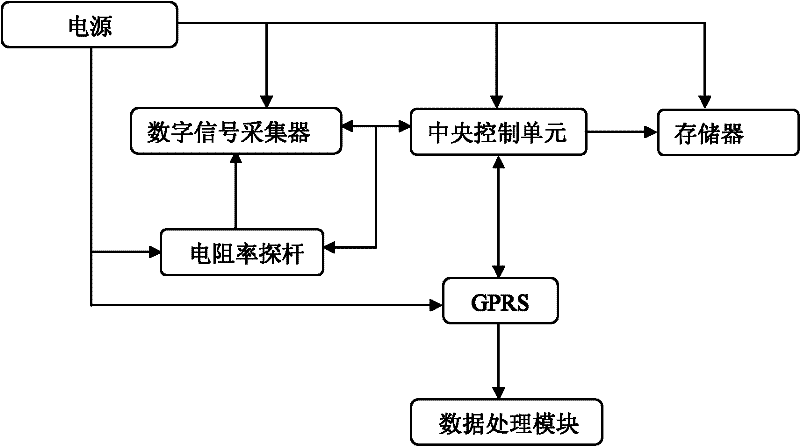An in-situ automatic monitoring method and system for vertical distribution of sediment concentration in seawater
A technology of automatic monitoring and vertical distribution, applied in the direction of material resistance, etc., can solve the problems of high time frequency, scattered data, high cost, etc., and achieve the effect of good measurement effect and guaranteed accuracy.
- Summary
- Abstract
- Description
- Claims
- Application Information
AI Technical Summary
Problems solved by technology
Method used
Image
Examples
Embodiment 1
[0031] The establishment of embodiment 1 standard curve and the screening of electrode spacing
[0032] The sand taken from Shilaoren Beach in Qingdao was treated with salt washing, and dried in an electric blast dryer at 105°C. The dried sand samples were mixed with seawater from this sea area in a water tank. Form suspended sand samples with different concentrations, the seawater salinity is 31.9‰, and the resistivity probe rods with the electrode spacing of 0.5cm, 1cm, 1.5cm, and 2cm are fixed vertically in the water tank in turn, and the measurement of the conductivity value is started. At the same time, Use the suspended sediment sampler to collect suspended sand samples corresponding to a certain position of the probe rod in a 50ml suspended sand sampling tube, transfer the suspended sand samples in the centrifuge tube into a small beaker that has been weighed and dried, and put the small beaker into After drying in the oven, weigh it to get the actual sediment concentra...
Embodiment 2
[0053] Application of embodiment 2 in-situ monitoring system
[0054] The field test was carried out on the beach of Qingdao No. 1 Bathing Beach. At low tide, the entire monitoring system was fixed at the monitoring point. The resistivity probe rod with an electrode spacing of 1.5cm was vertically fixed on the tripod. When the tide rose, the probe rod began to collect data. Around 5-10cm away from the probe rod. At the same time, use the traditional six-point method to collect sand-containing water samples at relative water depths of 1.0, 0.8, 0.6, 0.4, 0.2 and 0.0m, and take them back to the laboratory to measure the suspended sediment concentration, and establish a standard curve. See examples for specific methods. 1. The salinity of this sea area is 32.1‰, and the seawater temperature is 25.1°C. During the whole measurement process, the temperature is basically kept constant. Then, the collected data is remotely transmitted to the data processing module through the centra...
PUM
 Login to View More
Login to View More Abstract
Description
Claims
Application Information
 Login to View More
Login to View More - R&D
- Intellectual Property
- Life Sciences
- Materials
- Tech Scout
- Unparalleled Data Quality
- Higher Quality Content
- 60% Fewer Hallucinations
Browse by: Latest US Patents, China's latest patents, Technical Efficacy Thesaurus, Application Domain, Technology Topic, Popular Technical Reports.
© 2025 PatSnap. All rights reserved.Legal|Privacy policy|Modern Slavery Act Transparency Statement|Sitemap|About US| Contact US: help@patsnap.com



